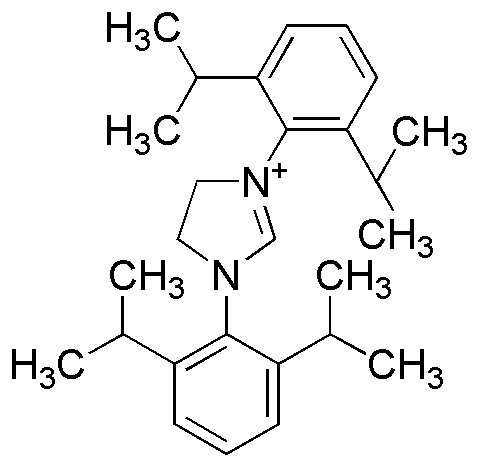1,3-Bis(2,6-diisopropylphenyl)imidazolinium chloride is widely utilized in research focused on:
- Catalysis: This compound serves as a highly effective catalyst in various organic reactions, enhancing reaction rates and selectivity, which is crucial for industries like pharmaceuticals and fine chemicals.
- Electrochemistry: It plays a significant role in electrochemical applications, particularly in the development of advanced batteries and fuel cells, offering improved efficiency and stability compared to traditional catalysts.
- Material Science: The compound is used in synthesizing novel materials, including polymers and nanomaterials, which are essential in electronics and coatings, providing superior properties like durability and conductivity.
- Medicinal Chemistry: Researchers leverage its unique properties to design and develop new therapeutic agents, particularly in oncology, where it can enhance drug efficacy and reduce side effects.
- Environmental Applications: It is also explored for its potential in environmental remediation, aiding in the degradation of pollutants, thus contributing to cleaner industrial processes and sustainable practices.
General Information
Properties
Safety and Regulations
Applications
1,3-Bis(2,6-diisopropylphenyl)imidazolinium chloride is widely utilized in research focused on:
- Catalysis: This compound serves as a highly effective catalyst in various organic reactions, enhancing reaction rates and selectivity, which is crucial for industries like pharmaceuticals and fine chemicals.
- Electrochemistry: It plays a significant role in electrochemical applications, particularly in the development of advanced batteries and fuel cells, offering improved efficiency and stability compared to traditional catalysts.
- Material Science: The compound is used in synthesizing novel materials, including polymers and nanomaterials, which are essential in electronics and coatings, providing superior properties like durability and conductivity.
- Medicinal Chemistry: Researchers leverage its unique properties to design and develop new therapeutic agents, particularly in oncology, where it can enhance drug efficacy and reduce side effects.
- Environmental Applications: It is also explored for its potential in environmental remediation, aiding in the degradation of pollutants, thus contributing to cleaner industrial processes and sustainable practices.
Documents
Safety Data Sheets (SDS)
The SDS provides comprehensive safety information on handling, storage, and disposal of the product.
Product Specification (PS)
The PS provides a comprehensive breakdown of the product’s properties, including chemical composition, physical state, purity, and storage requirements. It also details acceptable quality ranges and the product's intended applications.
Certificates of Analysis (COA)
Search for Certificates of Analysis (COA) by entering the products Lot Number. Lot and Batch Numbers can be found on a product’s label following the words ‘Lot’ or ‘Batch’.
*Catalog Number
*Lot Number
Certificates Of Origin (COO)
This COO confirms the country where the product was manufactured, and also details the materials and components used in it and whether it is derived from natural, synthetic, or other specific sources. This certificate may be required for customs, trade, and regulatory compliance.
*Catalog Number
*Lot Number
Safety Data Sheets (SDS)
The SDS provides comprehensive safety information on handling, storage, and disposal of the product.
DownloadProduct Specification (PS)
The PS provides a comprehensive breakdown of the product’s properties, including chemical composition, physical state, purity, and storage requirements. It also details acceptable quality ranges and the product's intended applications.
DownloadCertificates of Analysis (COA)
Search for Certificates of Analysis (COA) by entering the products Lot Number. Lot and Batch Numbers can be found on a product’s label following the words ‘Lot’ or ‘Batch’.
*Catalog Number
*Lot Number
Certificates Of Origin (COO)
This COO confirms the country where the product was manufactured, and also details the materials and components used in it and whether it is derived from natural, synthetic, or other specific sources. This certificate may be required for customs, trade, and regulatory compliance.


